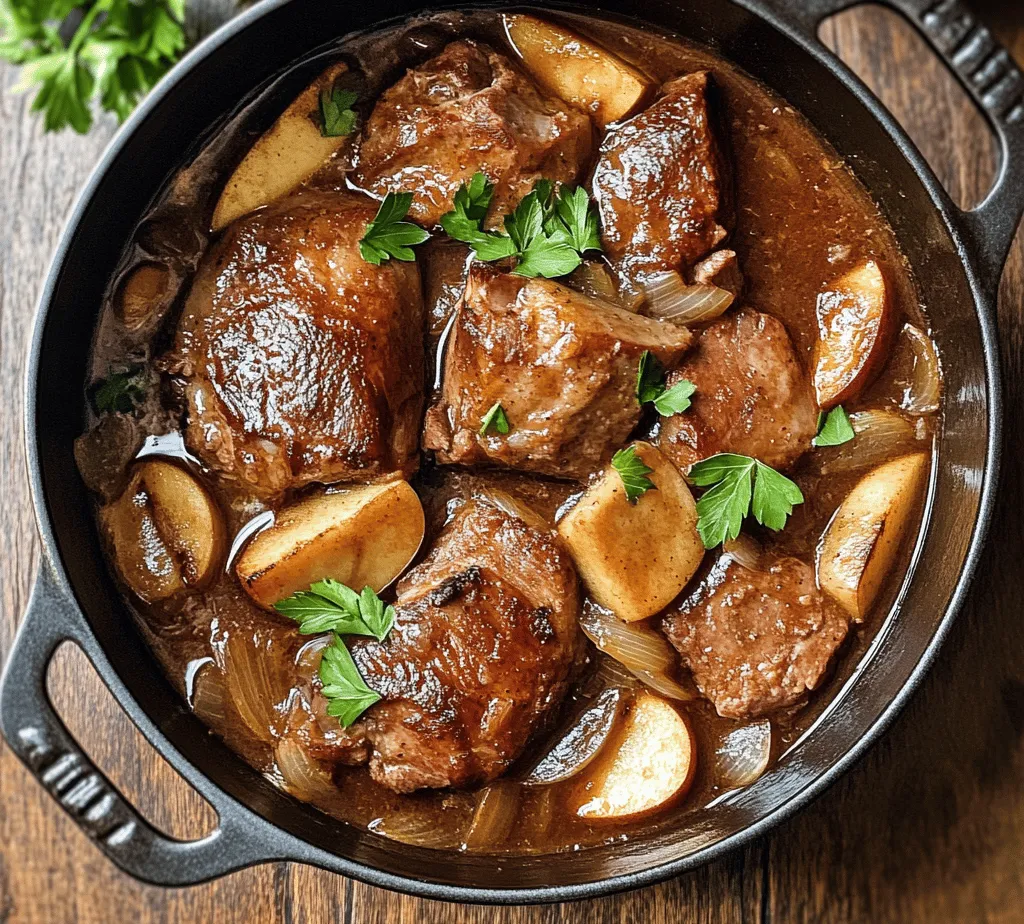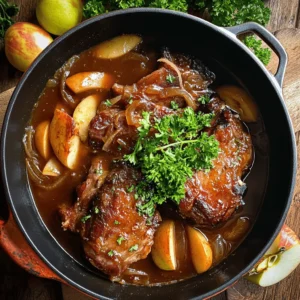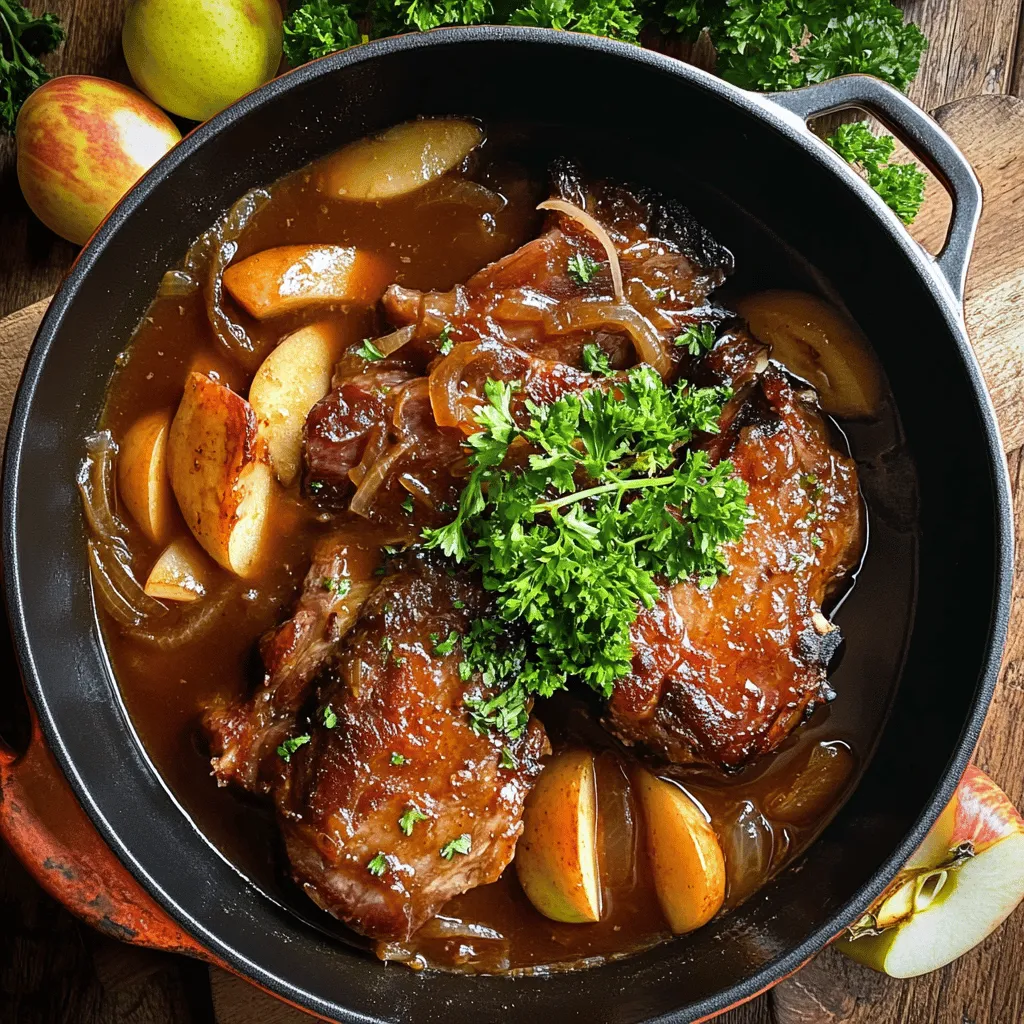Introduction
As the leaves change color and the air turns crisp, there’s a certain comfort that comes with hearty, warming meals. One dish that perfectly embodies the essence of autumn is Apple Cider Braised Pork Shoulder. This flavorful, tender pork dish is not only a feast for the senses but also a celebration of seasonal flavors that evoke feelings of comfort and nostalgia. The combination of savory pork with the sweet and tangy notes of apple cider creates an irresistible harmony, making this recipe a must-try for anyone looking to embrace fall cooking.
Apple cider, a quintessential autumn beverage, plays a starring role in this recipe. Its natural sweetness and acidity work together to tenderize the pork while imparting a rich, complex flavor profile that elevates the dish to new heights. As the pork shoulder braises, it absorbs the fragrant notes of the cider, along with the aromatic vegetables and spices, resulting in a deeply satisfying meal that is perfect for family gatherings or cozy dinners.
This recipe also highlights the cultural significance of braising, a cooking technique that has been used for centuries to transform tough cuts of meat into succulent, flavorful dishes. Braising not only enhances the taste of the meat but also allows for the marriage of flavors as the ingredients meld together over time. Whether you’re gathering around the dinner table with loved ones or simply indulging in a comforting meal on a chilly evening, Apple Cider Braised Pork Shoulder is sure to become a cherished favorite in your culinary repertoire.
Understanding the Ingredients
Overview of the Main Ingredient: Pork Shoulder
At the heart of this delectable dish is the pork shoulder, a cut of meat known for its rich flavor and tenderness. Also referred to as pork butt or Boston butt, pork shoulder is a well-marbled cut that comes from the upper part of the pig’s front leg. This marbling is essential for braising, as the fat renders during cooking, resulting in moist, tender meat that is bursting with flavor.
Pork shoulder is ideal for braising due to its relatively tough texture and connective tissues, which break down beautifully over low and slow cooking processes. This transformation is what makes the meat so tender and flavorful, as the collagen melts into the cooking liquid, creating a luscious sauce that coats the pork.
The Role of Apple Cider in Flavor Development
Apple cider plays a crucial role in this recipe, acting as both a marinade and cooking liquid. Its natural sugars contribute to caramelization, while the acidity helps to tenderize the meat. As the pork shoulder braises in the cider, it takes on a delightful sweetness that balances the savory elements of the dish. The apple cider not only enhances the overall flavor profile but also adds a seasonal touch that resonates with the flavors of fall.
Importance of Aromatics: Onions and Garlic
No braised dish is complete without the addition of aromatics, and in this recipe, onions and garlic are essential for building depth of flavor. Onions, when sautéed, release their natural sugars, becoming sweet and caramelized, while garlic provides a robust, savory note that complements the pork perfectly. Together, these aromatics create a flavorful base that enhances the overall dish and adds richness to the sauce.
The Use of Apples: Best Varieties and Their Flavor Profiles
To elevate the dish further, fresh apples are incorporated into the braise. Choosing the right variety of apple is key to achieving the desired flavor. For this recipe, consider using tart apples such as Granny Smith or Honeycrisp, which hold their shape during cooking and provide a pleasant contrast to the sweetness of the cider. The addition of apples not only enhances the dish’s flavor but also adds a lovely texture that complements the tender pork.
Overview of Additional Seasonings: Mustard, Brown Sugar, Thyme, and Cinnamon
In addition to the core ingredients, a blend of seasonings is used to create a well-rounded flavor profile. Dijon mustard adds a subtle tanginess that cuts through the richness of the pork, while brown sugar contributes a hint of caramelization and depth. Fresh thyme lends an earthy aroma that pairs beautifully with the apple and pork, creating a warm, inviting dish. Lastly, a touch of cinnamon introduces a warm spice that echoes the flavors of fall, tying the entire dish together.
Preparation Steps Explained
Importance of Proper Seasoning
Before diving into the cooking process, it’s essential to properly season the pork shoulder. Seasoning is fundamental to enhancing the natural flavors of the meat and ensuring that every bite is delicious. Generously salt the pork shoulder at least an hour before cooking, or even overnight if time permits. This allows the salt to penetrate the meat, improving flavor and moisture retention during the braising process.
How to Season the Pork Shoulder Effectively
To season the pork shoulder effectively, use a combination of kosher salt and freshly ground black pepper. Rub the mixture thoroughly all over the surface of the meat, ensuring an even coating. This initial seasoning sets the stage for the flavors to develop throughout the cooking process.
Searing the Meat
Next, heat a large, heavy-bottomed pot or Dutch oven over medium-high heat and add a few tablespoons of oil. Once the oil is shimmering, carefully place the seasoned pork shoulder into the pot, allowing it to sear undisturbed for a few minutes. This step is crucial, as the Maillard reaction—the browning that occurs when proteins are exposed to high heat—creates a rich, caramelized crust that enhances the dish’s overall flavor.
The Maillard Reaction and Its Benefits for Flavor
The Maillard reaction is a key component of creating depth in braised dishes. As the pork shoulder sears, it develops a golden-brown crust that not only adds visual appeal but also infuses the dish with an array of complex flavors. After a few minutes, use tongs to carefully turn the pork, searing all sides until evenly browned. Once seared, remove the pork from the pot and set it aside while you prepare the aromatics.
Sautéing the Vegetables
With the pot still hot, add chopped onions and minced garlic to the residual fat. Sauté the vegetables for a few minutes, stirring frequently, until they become translucent and fragrant. This step builds the foundation of flavor that will permeate the entire dish. The sweetness of the onions will begin to caramelize, releasing their natural sugars and enhancing the overall taste of the braise.
Techniques for Achieving the Right Texture and Aroma
As the onions and garlic sauté, it’s important to scrape up any browned bits from the bottom of the pot. These flavorful morsels, known as fond, are a treasure trove of taste that will enhance the sauce. Stir the vegetables occasionally to ensure they cook evenly and develop a rich aroma.
Combining Liquids and Seasonings
Once the onions and garlic are perfectly sautéed, it’s time to return the seared pork shoulder to the pot. Pour in the apple cider, followed by any additional liquids—such as chicken broth or water—needed to ensure the pork is partially submerged. The balance of liquids is crucial, as it allows for even cooking while preventing the dish from becoming too dry.
Balancing Flavors for a Harmonious Braise
To create a harmonious flavor profile, add the mustard, brown sugar, thyme, and cinnamon to the pot. Stir everything together, ensuring that the seasonings are well-distributed throughout the liquid. This step is essential for achieving a balanced taste, as each ingredient contributes its unique character to the final dish.
The Layering of Ingredients: Apples and Pork
Finally, it’s time to layer in the fresh apple slices. Arrange the apples around the pork shoulder, ensuring that they are nestled within the liquid. This technique allows the apples to soften and infuse their flavor into the braise while providing a delightful contrast in texture when served. Cover the pot with a tight-fitting lid and bring the mixture to a gentle simmer.
The slow braising process will allow the flavors to meld beautifully, creating a dish that is as comforting as it is delicious. As the pork shoulder cooks low and slow, it will become incredibly tender and infused with the sweet and savory notes of apple cider and aromatic ingredients.
Stay tuned for the next part of this article, where we will discuss the final cooking process and serve suggestions for this delightful Apple Cider Braised Pork Shoulder recipe.

The Braising Process
Braising is a time-honored cooking technique that transforms tough cuts of meat into succulent, flavorful dishes. This method combines both dry and wet cooking techniques, first searing the meat to develop a rich browning on the outside, then slowly simmering it in a liquid to infuse flavor and tenderize the meat. The process is ideal for cuts like pork shoulder, which benefit from low and slow cooking to break down connective tissues and enhance tenderness.
Ideal Cooking Time and Temperature for Perfect Tenderness
For apple cider braised pork shoulder, the ideal cooking time is typically between 3 to 4 hours at a consistent low temperature, around 300°F (150°C). This slow cooking allows the pork to absorb the flavors of the cider and aromatics while becoming fork-tender. It’s crucial to maintain a steady temperature to prevent the meat from drying out, ensuring that it remains juicy and flavorful.
Signs That the Pork is Done
Determining doneness when braising pork can be achieved through a few simple checks. The most telling sign is the texture of the meat. When the pork shoulder is finished, it should be easily pulled apart with a fork, indicating that the connective tissues have broken down sufficiently. A meat thermometer can also be utilized; the internal temperature should reach around 190°F to 200°F (88°C to 93°C) for optimal tenderness.
Importance of Fork-Tender Texture
Achieving a fork-tender texture is the hallmark of successful braising. This means that the meat should yield easily when a fork is inserted, separating into tender shreds. The process allows the flavors from the braising liquid to penetrate deeply into the pork, creating a luscious, moist dish that is bursting with flavor.
Resting the Meat
Once the braising is complete, it is essential to allow the pork shoulder to rest before serving. Resting the meat for at least 15 to 20 minutes helps to redistribute the juices that have been drawn out during cooking. This ensures that when the meat is sliced or pulled, it remains juicy and flavorful, rather than losing moisture onto the cutting board.
Why Resting is Crucial for Juicy Results
Resting is not just a matter of convenience; it is a crucial step that enhances the overall eating experience. When meat is cooked, the fibers tighten and push out moisture. Allowing time for the meat to rest lets those fibers relax, leading to a more tender texture and a juicier final product. Skipping this step may result in a dry dish that doesn’t showcase the full potential of the braised pork.
Skimming Excess Fat
Before serving the braised pork shoulder, it’s advisable to skim off any excess fat that may have accumulated on the surface of the sauce. This not only helps in creating a cleaner, more appealing sauce but also makes for a healthier dish. Use a ladle or a spoon to carefully remove the excess fat, taking care not to disturb the flavorful juices beneath. This technique can significantly enhance the overall taste and presentation of your dish.
Serving Suggestions
Presentation is key when it comes to serving apple cider braised pork shoulder. Here are some creative ideas to elevate your dining experience:
How to Plate the Pork Shoulder with Gravy and Apples
Start by placing a generous portion of the pulled pork shoulder onto the plate, allowing its savory juices to flow naturally. Drizzle the rich apple cider gravy over the top, ensuring that each bite is infused with flavor. For a touch of elegance, garnish the dish with caramelized apple slices and freshly chopped herbs, such as thyme or parsley, adding both color and freshness.
Side Dishes That Complement Braised Pork
Pair your braised pork shoulder with side dishes that enhance the overall meal. Consider serving it alongside creamy mashed potatoes or buttery polenta to soak up the delicious gravy. Roasted root vegetables, such as carrots and parsnips, add a hint of sweetness and a rustic touch. A crisp, tangy coleslaw can provide a refreshing contrast to the richness of the pork, balancing out the meal perfectly.
Suggestions for Balance and Harmony
To achieve harmony on your plate, think about textures and flavors. The rich and hearty braised pork can be beautifully complemented by lighter, brighter sides. Consider a simple arugula salad dressed with a citrus vinaigrette, which can cut through the richness of the dish while introducing a refreshing note. Additionally, a side of sautéed green beans or garlic sautéed spinach can provide a vibrant green contrast.
Wine Pairings with Apple Cider Braised Pork
When it comes to wine pairings, apple cider braised pork shoulder pairs beautifully with a variety of options. A medium-bodied red wine, such as Pinot Noir or Merlot, can enhance the flavors of the pork while complementing the sweetness of the cider. If you prefer white wine, a crisp Chardonnay or a lightly oaked Viognier can also work well, offering a nice balance to the dish. For a non-alcoholic option, consider serving fresh apple cider or a sparkling apple juice to echo the flavors in the dish.
Recommendations for Enhancing the Meal Experience
To fully enjoy your apple cider braised pork shoulder, set the scene for a comforting dining experience. Use warm, inviting table settings and perhaps light some candles to create a cozy ambiance. Consider playing soft background music that enhances the mood. The joy of cooking is not just in the meal itself but in the experience of sharing it with loved ones.
Nutritional Information
Understanding the nutritional breakdown of apple cider braised pork shoulder can help you appreciate the dish’s health benefits while enjoying its rich flavors.
Breakdown of Key Nutrients in the Dish
A typical serving of apple cider braised pork shoulder offers a hearty dose of protein, essential for muscle repair and growth. Pork shoulder is a great source of high-quality protein, providing approximately 24 grams per serving. Additionally, the dish features nutritious ingredients like apples and onions, contributing vitamins and minerals that benefit overall health.
Protein Content from Pork
Pork shoulder is rich in protein, making it an excellent choice for those looking to increase their protein intake. This macronutrient is essential for various bodily functions, including enzyme production and immune system support. The combination of protein from the pork and fiber from accompanying vegetables creates a balanced meal.
Health Benefits from Apples and Onions
Adding apples not only enhances the flavor profile of the dish but also introduces health benefits. Apples are a good source of dietary fiber, vitamin C, and various antioxidants, which can aid in digestion and boost the immune system. Onions, too, provide health benefits, including anti-inflammatory properties and antioxidants that contribute to heart health.
Caloric Considerations for Serving Sizes
While apple cider braised pork shoulder is undoubtedly indulgent, it can still fit into a balanced diet when enjoyed in moderation. A standard serving size contains approximately 350-450 calories, depending on the portion of pork and accompanying sides. Being mindful of serving sizes can help maintain a healthy balance while enjoying this comfort dish.
Balancing Indulgence with Nutrition
As with any decadent dish, balance is key. Enjoying apple cider braised pork shoulder as part of a well-rounded meal that includes vegetables and whole grains can contribute to a healthy lifestyle. Emphasizing moderation allows you to savor the flavors while ensuring you receive essential nutrients.
Conclusion
In summary, apple cider braised pork shoulder is a standout dish that combines rich flavors, tender textures, and the joy of comfort food. The braising process transforms an ordinary cut of meat into a culinary masterpiece, perfect for family gatherings or special occasions. Its savory depth is complemented by the sweetness of apples and the warmth of spices, creating a meal that is both satisfying and memorable.
Cooking and sharing meals like this one is not just about nourishment; it’s about creating experiences and building connections with those you love. The aroma of the braising pork wafting through your home, the anticipation of serving a beautifully plated dish, and the smiles around the table all contribute to the joy of cooking. Embrace the process, enjoy the flavors, and relish the moments spent with family and friends as you create and savor this delightful apple cider braised pork shoulder.



